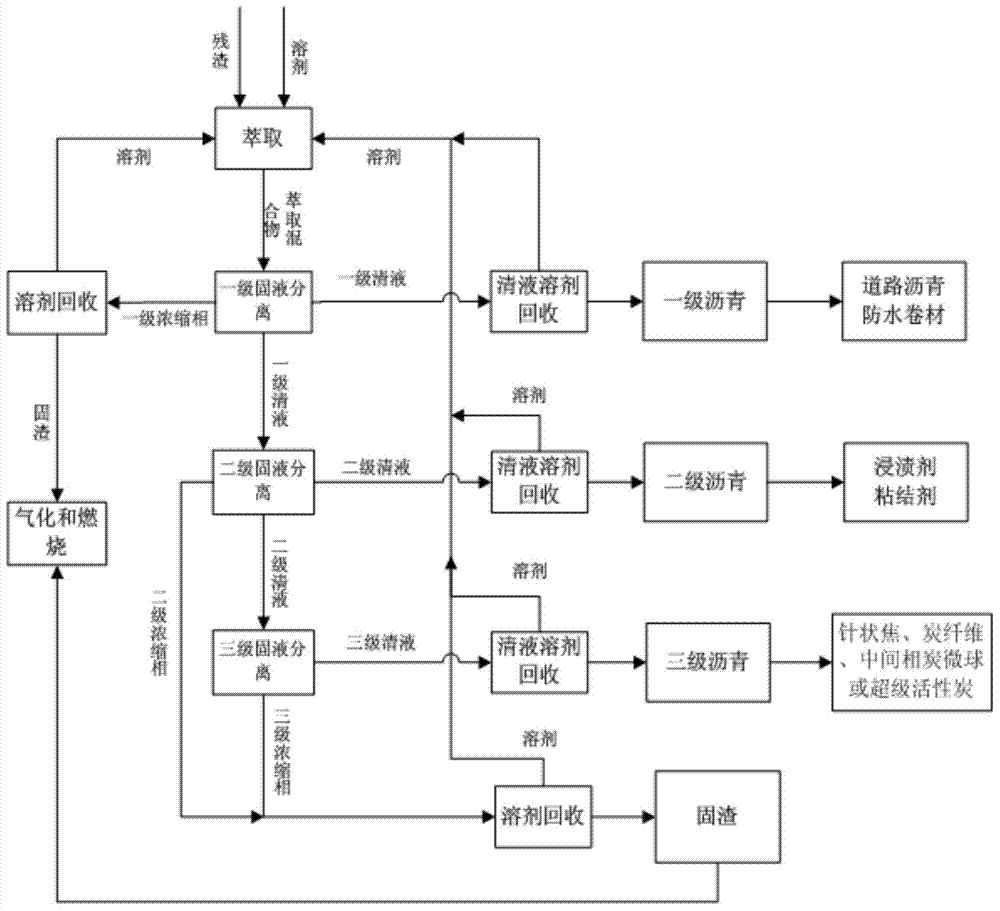Treatment method for direct coal liquefaction residues
A technology of direct coal liquefaction and treatment method, which is applied in the field of coal chemical industry, can solve the problem of low additional income value, avoid high cost and realize the effect of large-scale industrial production application
- Summary
- Abstract
- Description
- Claims
- Application Information
AI Technical Summary
Problems solved by technology
Method used
Image
Examples
Embodiment 1
[0040] Mix the coal direct liquefaction residue (300kg / h) and tetrahydrofuran (300kg / h) in a 50L stirred tank, the stirred tank is protected with nitrogen, and the extraction process is carried out at a pressure of 0.02MPa and a constant temperature of 60°C to obtain an extraction mixture .
[0041] The above-mentioned extraction mixture enters the primary cyclone separator for primary solid-liquid separation, the cyclone temperature is 60°C, and the inlet pressure of the primary cyclone separator is 0.2MPa; after the primary solid-liquid separation, the primary concentrated phase The flow rate is 185kg / h, and the total flow rate of the primary clear liquid is 415kg / h, of which 265kg / h primary clear liquid is sent to the secondary internal cross-flow filter for secondary solid-liquid separation.
[0042] In the secondary solid-liquid separation process, the separation temperature is 60°C, the inlet pressure of the secondary internal cross-flow filter is 0.2MPa, and the pore si...
Embodiment 2
[0048] Mix the coal direct liquefaction residue (250kg / h) and quinoline (500kg / h) in a 120L stirred tank, the stirred tank is protected with nitrogen, and the extraction process is carried out at a pressure of 0.01MPa and a constant temperature of 100°C to obtain the extracted mixture.
[0049] Pass the above-mentioned extraction mixture into a primary centrifugal separator for primary solid-liquid separation, the centrifugal temperature is 100°C, the inlet pressure of the primary centrifugal separator is 0.05MPa, the speed of the centrifuge is 3000r / min, and after the primary solid-liquid separation Finally, the flow rate of the primary concentrated phase is 150kg / h, and the total flow rate of the primary clear liquid is 600kg / h, wherein 400kg / h of the primary clear liquid is sent to the secondary centrifuge for secondary solid-liquid separation.
[0050] During the secondary solid-liquid separation process, the separation temperature is 100°C, the inlet pressure of the secon...
Embodiment 3
[0056] Mix the coal direct liquefaction residue (250kg / h) and coal liquefaction medium oil (120-280°C fraction, 1000kg / h) in a 300L stirred tank. The stirred tank is protected by nitrogen, and the pressure is 0.01MPa, and the temperature is 120°C. Next, the extraction process is carried out to obtain an extraction mixture.
[0057] Pass the above-mentioned extraction mixture into a primary centrifugal separator for primary solid-liquid separation, the centrifugal temperature is 120°C, the inlet pressure of the primary centrifugal separator is 0.06MPa, and the centrifuge speed is 4000r / min. After primary separation, The flow rate of the primary concentrated phase is 170kg / h, the total flow rate of the primary clear liquid is 1080kg / h, and 700kg / h of the primary clear liquid is sent to the secondary cyclone separator for secondary solid-liquid separation.
[0058] During the secondary solid-liquid separation process, the cyclone temperature is 120°C, and the inlet pressure of th...
PUM
| Property | Measurement | Unit |
|---|---|---|
| Softening point | aaaaa | aaaaa |
| Softening point | aaaaa | aaaaa |
| Softening point | aaaaa | aaaaa |
Abstract
Description
Claims
Application Information
 Login to View More
Login to View More - R&D
- Intellectual Property
- Life Sciences
- Materials
- Tech Scout
- Unparalleled Data Quality
- Higher Quality Content
- 60% Fewer Hallucinations
Browse by: Latest US Patents, China's latest patents, Technical Efficacy Thesaurus, Application Domain, Technology Topic, Popular Technical Reports.
© 2025 PatSnap. All rights reserved.Legal|Privacy policy|Modern Slavery Act Transparency Statement|Sitemap|About US| Contact US: help@patsnap.com

